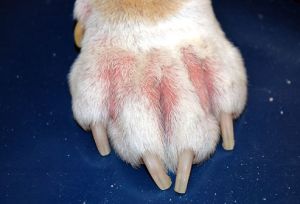Being a dog allergies parent is not an easy task at all, and we are going to discuss one factor that specifically makes this true – dog allergies. The one physical condition that makes both humans and dogs wary: an allergy! Just like humans, dogs are prone to allergies and everyday items may cause extreme physical reactions.
While dog allergies are found across all breeds and can vary from individual to individual, they usually occur between 1-3 years of age and are most common among Golden Retrievers, Terriers, Pugs and Bulldogs.
Types of Common Dog AllergiesDog allergies are numerous, but can be classified into two main types: food and environmental. Unfortunately, your dog can be allergic to nearly any food, owing to genetics and early upbringing. Most common dog allergies that stem from food, however, are associated with chicken, rice, soy, wheat, corn, and eggs.
Certain prescription drugs may also trigger allergies. Environmental dog allergies, on the other hand, can come from things like grass, plants, pollen, dust, mold, dander, smoke, and perfumes. They may also come from specific fabrics or materials, like wool, rubber or plastic, as well as from products like certain shampoos or soaps. Skin reactions and rashes occurring due to these materials come under the umbrella term, Atopy.
Common Symptoms of Dog AllergiesWhy dog allergies develop is something that cannot be answered definitively, since both genetic and environmental factors may be contributors. But we do know that most allergies cause symptoms that are easily identifiable. These may include:
- Obsessive scratching and/or licking the body
- Constant head shaking
- Paw biting
- Itchy and red skin, or rashes
- Itchy and watery eyes
- Red underbelly
- Excessive sneezing
- Nausea and vomiting
- Diarrhea

While these symptoms may be associated with different kinds of allergies, there are a few symptoms that almost certainly signify food allergies:
- Red or brown nail beds
- Browning lips
- Itchy or red ears
First off, when you notice early signs of symptoms, a trip to your local vet may help. The vet would usually diagnose the cause of the allergies visually and recommend the appropriate treatment for each symptom.
While the symptoms of dog allergies seem straightforward enough, the fact is that they may well be caused by other factors, like a one-time encounter with a dirty fabric, a new bathing product, injury, seasonal change, or diseases. Therefore, you must not always take one or more of these symptoms to mean that your dog has an allergy. It is recommend you take your pet to the vet as soon as you discover something is off and let them conduct a thorough observation.

Vets in Singapore usually prescribe oral steroids and antihistamines – steroids to help with the itch, and antihistamines to reduce the allergic reaction. It is possible that your vet will prescribe drugs like Benadryl to rule out other factors that may be triggering the symptoms. Specifically for itchy skin problems, they might recommend moisturising through physical (lotions/creams) as well as dietary means.
Sometimes, they might also wait for the weather to change to see if an improvement occurs. When none of the treatments work and the problem persists, that is when your vet would most likely recommend certain skin or blood tests to determine if your dog has an allergy. For environmental allergies, for example, intradermal testing may be carried out, where a small amount of the most common allergens is injected just under the skin and then observed for reactions.
Identifying and Eliminating Food AllergensYour vet may recommend a “hypoallergenic” prescription diet kibble to you from brands such as Hill’s Science Diet or Royal Canin; this is made with hydrolysed protein, which may or not make work. For example, if your dog is allergic to chicken, feeding him food that has a high content of hydrolysed protein made from chicken meat would not have as much effect as completely avoiding chicken.
The problem is that there are so many meats (and other ingredients, such as certain vegetables) your dog could be allergic to. Hence, the primary way to find out whether your dog has a food allergy and what foods he is allergic to, is to put him on a food elimination diet. The food elimination diet is very similar to a limited ingredient diet; it only consist of only two ingredients. Vets who prefer this holistic approach usually recommend starting with one protein and one carbohydrate, based on your dog’s history.
For example, you might be required to feed your dog nothing except sweet potatoes and turkey. This prescribed diet has to be strictly followed for 12 weeks. During this time, symptoms may initially persist but eventually fade away near the end of the trial period, thus confirming that the allergy was caused by your dog’s diet!

This is then followed by introducing other food items one by one – for four days at a time – to see which one was the cause of the allergy. This will determine exactly what caused the symptoms! The process is certainly tedious, but it is highly effective and fail-safe.
How to Treat Dog AllergiesHow you deal with a certain allergy your pup is suffering from will depend entirely on the type of the allergy. Depending on whether it’s a food or an environmental allergy, you will have to take precautionary steps, eventually turning them into lifestyle changes.
Treating Food Allergies
The first step is to identity the food that’s causing the allergy, with the aforesaid method of identifying food allergens. Once you know which specific food is the cause, it is then time to sit down with your vet to devise a meal plan that is healthy and nutritious, especially if a major chunk of the previous diet has now been identified as allergic.
While many dog parents dread this, home cooked food might be the way to go, especially in the case of severe allergies. It is the only way you will be able to control exactly what goes into your dog’s food, and there will be no accidental inclusion of an allergen.
If it seems like this is an area you might want to explore, read more in our detailed blogpost, ’Home Cooked Food for Dogs’. However, we do understand that not everyone has the time to make home cooked food for their dog, and some might just feel that they are not ready to take a responsibility as big. In this case, you would certainly want to keep the following in mind:
- Carefully choose your commercial foods and always make sure you always read labels, especially the ingredients list thoroughly. Sure, you might have to spend a little more than usual since you now have to be picky about what to buy, but it will be worth your pet’s health – in addition to the money you will save by not having to visit the vet repeatedly.
- Find foods that are preferably supplemented with fatty acids, such as ingredients like salmon and fish oil have a higher Omega fatty acid content. They can improve your dog’s skin condition, unless your dog is allergic to fish.
- Know dog food lingo when you’re reading labels and ingredient lists. Remember that unless you see ‘grain free’, there is a high chance that your dog’s food contains rice and/or other grains. Also note that ‘hypoallergenic’ does not necessarily mean it is safe for your itchy dog; there is always a chance it might contain something that your dog is allergic to, so keep an eye out for such ingredients!
Treating Environmental Allergies
With environmental dog allergies, treatment may seem more straightforward but still involves extreme vigilance and everyday changes that must last forever. Once you’ve identified the allergen, the following steps may be taken:
- Use an air purifier and air conditioner for allergens like dust and pollen
- Limit access to fabrics and materials causing allergies. This may be rather tricky. For example, in case of rubber allergies, you will have to tuck away all rubber slippers, gloves and other items out of your pet’s reach
- To regularly combat environmental dog allergies, use a hypoallergenic shampoo to bathe your dog at least once a week
- Make it a habit to thoroughly clean your dog – even just with a dry brush or duster – every time they come home from an outdoor visit. Make sure you remove any potential pollen, dust or grass caught in the fur
- Invest in natural sprays or ointments to soothe and calm your dog’s skin, or make your own with natural ingredients like aloe vera and oatmeal.
Medical treatments for dog allergies are available, and range from quite safe to fairly risky. Remember that these must be discussed with your vet, since there is no one-size-fits-all rule that can be applied here.
- Use Supplements. Omega 3 and Biotin, both are highly recommended by experts since they are both excellent for treating itching and for promoting a healthy coat. However, your vet must be consulted to ensure this is suitable for your dog. To understand supplements better, read our blogpost, ‘Should I Give Supplements to My Dog?’
- Sulfodene. This is an approved formula to help with irritation, redness and rashes, and can be purchased in a spray form.
- Medicated sprays. There are several other types of medicated sprays that are aimed specifically at treating fungal and bacterial infections.
- Antihistamines. When mild sprays don’t work, your vet may recommend oral medication to help with allergic reactions. The most common antihistamines given to dogs are Benadryl and Diphendyramine.
- Cortisoids. When even mild and rather safe oral medication fails, your vet might resort to steroids to treat the problem. However, this treatment will only be short-term and aimed only at providing relief for particularly strong adverse reactions.
With medical treatments for dog allergies, the issue of whether or not they are safe depends on several factors. These include the extremity of the treatment, the generalisability of the treatment and, conversely, how individual factors come into play. Medical options are beneficial in that they can be resorted to when certain substances like dust cannot be entirely removed from the environment.
For example, since you cannot make sure that your dog absolutely does not come in contact with any dust, you can conveniently invest in a safe anti-itching spray aimed specifically at allergy relief. Such products cannot only provide immediate and convenient relief, but help improve your pet’s quality of life by letting them enjoy things like outdoor walks while still keeping them away from the frustration and pain that comes with suffering from an allergy.
Unfortunately, however, it can never be said that all medical treatments are entirely effective as well as safe. Antihistamines, for example, are known to work only on 30% of all dogs, which means that many dogs will undergo the experimental treatment with no fruitful results. On the other hand, steroid treatments are known to be dangerous for both dogs and humans in case they backfire or cause further problems. This is evident from the fact that they are never recommended as a long-term solution, though they may come in handy in emergency situations and short-term treatment plans.
Additionally, it must not be forgotten that prescription drugs can in turn cause their own allergic reactions. If not, they still may cause side effects like drowsiness, inactivity and nausea. Giving medication to your pet will never be a 100% safe choice that is guaranteed to work.
At the end of the day, you will have to let your pet undergo experimental treatments and risks if they are really suffering at the hands of an allergy – just like you would have to resort to medication if you yourself get an allergy, even when there is no guarantee that the medication will work.
In conclusion, it is about your pup’s quality of life, about ridding them of pain and disease, and about making sure that you make informed choices. Lifestyle changes and intensive lifelong care may be hard, but it will be worth your dog’s health and happiness, which will only contribute to longevity and better bonding with you!
